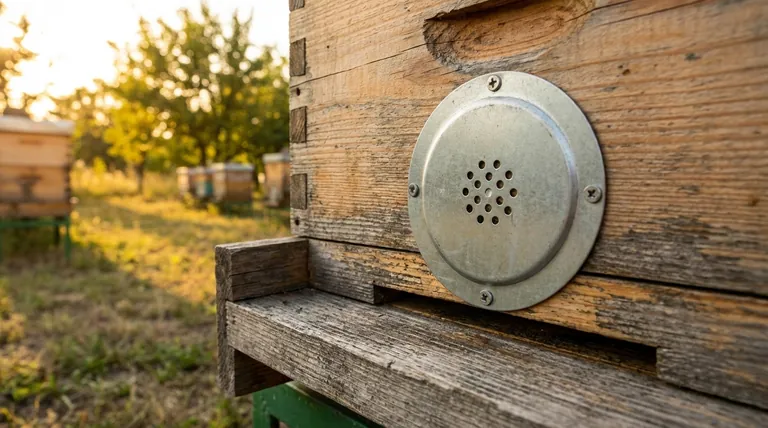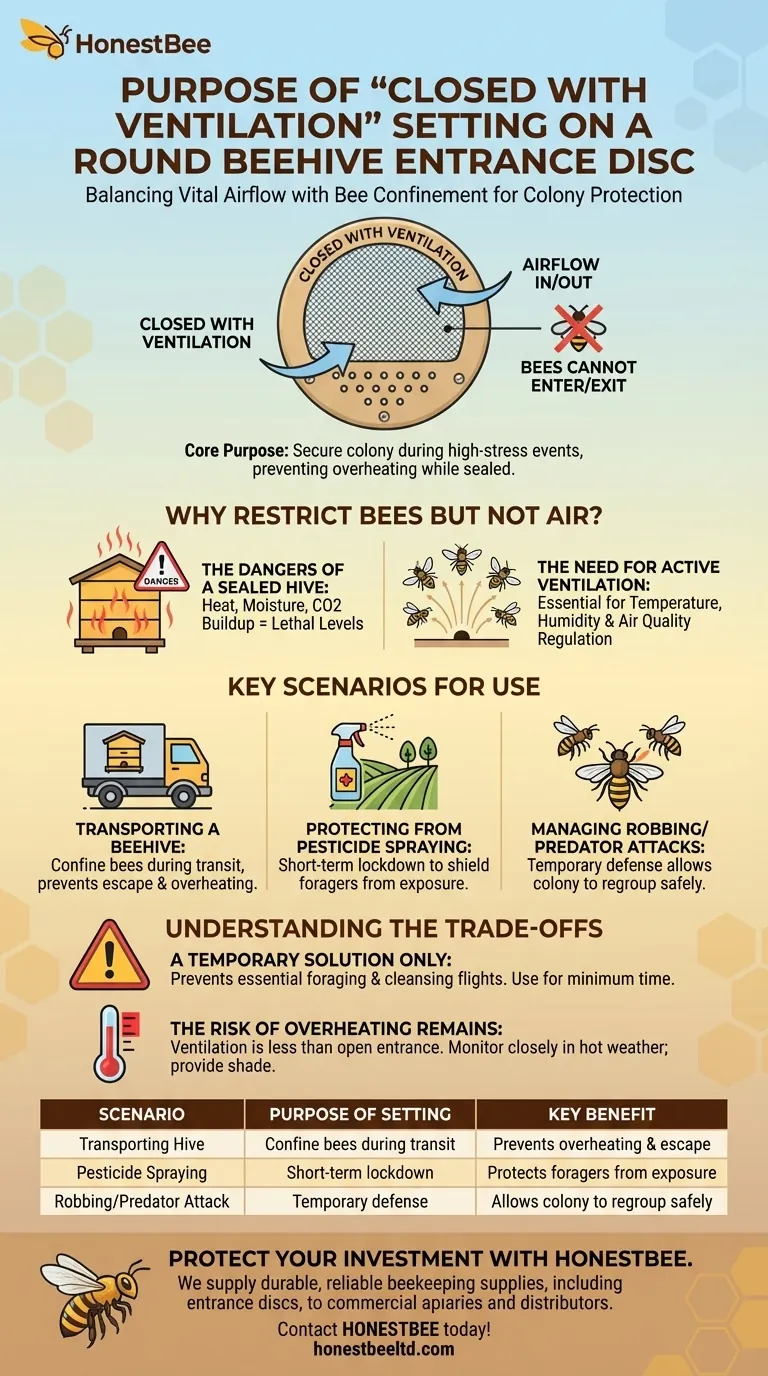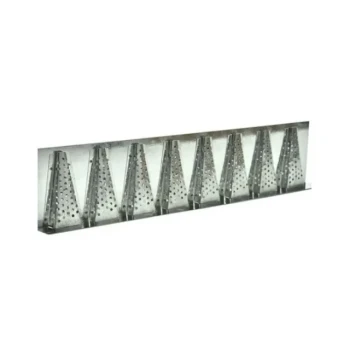The closed with ventilation setting on a beehive entrance disc is a specialized management tool designed for a single purpose: it allows vital airflow into the hive while completely preventing bees from entering or exiting. This function is critical for securing the colony during specific, high-stress situations.
The core purpose is colony protection. This setting is not for daily operation but is used to safely confine bees during temporary but high-risk events, such as transportation or exposure to nearby pesticides, preventing overheating while the hive is sealed.

Why Restrict Bees But Not Air?
A beehive is a living, breathing superorganism that actively manages its internal environment. Understanding this is key to seeing why ventilation is non-negotiable, even when the entrance must be closed.
The Dangers of a Sealed Hive
A colony of thousands of bees generates a significant amount of heat and moisture through metabolic activity.
If a hive is completely sealed with no airflow, the temperature can rise to lethal levels very quickly. The buildup of carbon dioxide and humidity would also suffocate the colony.
The Need for Active Ventilation
Bees naturally ventilate their hive by fanning their wings near the entrance to create air currents. This process is essential for regulating temperature, controlling humidity, and curing nectar into honey.
The "closed with ventilation" setting provides the passive airflow necessary for the bees' own fanning efforts to remain effective, even when they cannot leave the hive.
Key Scenarios for Using This Setting
This tool is exclusively for temporary confinement. Its use cases are specific and are meant to solve immediate, short-term problems.
Transporting a Beehive
This is the most common and critical application. When moving a hive, you must confine the bees to prevent them from escaping and getting lost or stinging you.
Closing the entrance with the ventilation setting ensures they can breathe and regulate temperature during the stress and agitation of the journey.
Protecting from Pesticide Spraying
If you are notified of pesticide application in your area, you can lock the hive down for a few hours to protect your foraging workforce from exposure.
This setting allows the colony to survive the confinement without overheating until the danger has passed.
Managing Robbing or Predator Attacks
In severe cases where one hive is being relentlessly "robbed" of its honey by stronger colonies, a beekeeper might temporarily close the entrance.
This gives the weaker colony a chance to regroup. The ventilation ensures this defensive measure doesn't inadvertently harm the colony you are trying to protect.
Understanding the Trade-offs
While incredibly useful, this setting is a tool of intervention and comes with inherent risks that must be managed.
A Temporary Solution Only
Confining bees prevents them from their essential daily tasks: foraging for nectar, pollen, and water, and carrying out cleansing flights.
This setting should only be used for the absolute minimum time required. It is a stressor on the colony and is not a long-term solution to any problem.
The Risk of Overheating Remains
While the setting provides ventilation, it is significantly less than a fully open entrance.
In extremely hot weather, a confined hive can still overheat. A beekeeper must provide shade and monitor the hive closely if using this setting on a hot day.
Making the Right Choice for Your Colony
Applying this tool correctly depends entirely on your immediate goal as a beekeeper.
- If your primary focus is moving your hive: Use the closed with ventilation setting to guarantee bee safety and prevent overheating during transit.
- If your primary focus is protecting from external threats: Use this setting as a short-term lockdown, ensuring the colony has vital air while confined from pesticides or robbers.
- If your primary focus is normal daily operation: This setting must be avoided, as the hive entrance should be appropriately open to allow for the essential foraging bees need to thrive.
Understanding how to use specialized tools like this empowers you to protect your colony effectively during its most vulnerable moments.
Summary Table:
| Scenario | Purpose of Setting | Key Benefit |
|---|---|---|
| Transporting Hive | Confine bees during transit | Prevents overheating & escape |
| Pesticide Spraying | Short-term lockdown | Protects foragers from exposure |
| Robbing/Predator Attack | Temporary defense | Allows colony to regroup safely |
Protect your investment and ensure your colony's safety with the right equipment. HONESTBEE supplies durable, reliable beekeeping supplies and equipment, including entrance discs, to commercial apiaries and distributors through our wholesale-focused operations. Let us help you manage your hives with confidence. Contact HONESTBEE today to discuss your needs!
Visual Guide

Related Products
- Beehive Entrance Reducer Guardian Metal Hive Entrance for Bees
- Steel Round Disc Entrance Reducer for Flexzion Bee Hive Nuc Box Gate
- Multi-Functional Rotary Hive Entrance Disc for Beekeeping
- Professional Reversible Beehive Hive Entrance
- Multi-Functional Sliding Hive Entrance for Beekeeping
People Also Ask
- What are the features of the side with oblong holes in the entrance reducer? A Guide to Hive Defense & Health
- What are the two functions of the Entrance Reducer? Master Hive Defense and Safe Transport
- What are the different entrance sizes for an 8 or 10-frame Langstroth hive? A Guide to Seasonal Management
- What are the different types of entrance reducers available? A Guide to Protecting Your Hive
- How can a Langstroth hive entrance be adjusted? Mimic Natural Bee Preferences for a Healthier Hive



















